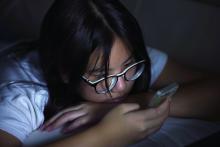Screen-based activities and sleep behaviors could be “intervention targets” for adolescents with depressive symptoms, results of a study of almost 3,000 U.S. adolescents suggest.
“Overall, our results indicated that [social messaging, Web surfing, TV/movie watching, and video gaming] ... were associated with greater depressive symptoms and poorer sleep characteristics,” Xian Li, PhD, and her associates reported in Sleep Medicine.
Numerous studies previously have demonstrated a positive link between adolescent depression and exposure to electronic devices, although little is known about the precise mechanism(s) of action involved and to what extent sleep plays a role. To address those gaps, Dr. Li, of the State University of New York at Stony Brook, and her associates examined four types of screen activities to determine whether symptoms of adolescent depression, sleep duration, and symptoms of insomnia – including problems falling asleep and staying asleep – are influenced in any way by those activities.
Using data from the Fragile Families and Child Wellbeing Study, a longitudinal urban birth cohort study that included an “oversampling of nonmarital births,” Dr. Li and her associates evaluated a total of 2,865 adolescents (mean 15.53 years of age; 48.2% female) self-identifying as African American (47.4%), Hispanic/Latino (23.7%), white (16.8%), or other/multiracial (12.1%). In participant interviews conducted with adolescents and caregivers during 2014-2016, 17.5% of caregivers reported having less than a high school education; 31.1% of teens lived in households below 100% of poverty; 32.8% came from single-mother families; and just 26.9% lived with both biological parents. The investigators assessed depressive symptoms at age 15 years by using five items from Center for Epidemiologic Studies Depression Scale.
Overall, Dr. Li and her associates found greater depressive symptoms associated with all four of the screen-based activities (P less than .01). In addition, more problems were observed with falling and staying asleep as well as shortened duration of sleep during the week for each of the activities monitored.
Social messaging, Web surfing, and time spent watching TV and movies appeared to be directly correlated with sleep characteristics, but the same could not be said for gaming, which showed only partial correlation with sleep characteristics. In that case, the authors speculated that the association between gaming and depression could be at least partly explained by individual characteristics such as trait neuroticism and self-control or a self-selection behavior in which those exhibiting greater signs of depression turn to gaming as an escape. “Thus, ,” Dr. Li and her associates wrote. The authors also noted a significant link between depressive symptoms at age 9 years and gaming behavior at age 15 years.
Several study limitations were noted. Causality and temporality could not be teased apart given that screen activities, sleep, and depressive symptoms all were measured concurrently at age 15 years. Screen activities also were noted to have captured only duration and not content or interactivity of the activities. Self-reports of screen time also might have been inaccurate because of general error in recall or even overlap in cases where participants were using more than one device simultaneously.
It is important to consider that while the relationships in the models might have statistical significance, “the effect size in the study as a whole are small.”
Nevertheless, they wrote, their findings “suggest that screen-based activities have negative implications for both sleep quality and sleep quantity, which further relates to depressive symptoms.”
Future studies should examine the “temporal sequencing” of those three limitations as well as adding more informants, including parent and teacher reports, and methods for objectively measuring screen activities and sleep, the authors cautioned.
The research was funded by the Eunice Kennedy Shriver National Institute of Child Health and Human Development of the National Institutes of Health, and several private foundations. Dr. Buxton received two subcontract grants to Pennsylvania State University from Mobile Sleep Technologies. Dr. Hale received an honorarium from the National Sleep Foundation for her role as editor in chief of the journal Sleep Health.
SOURCE: Li X et al. Sleep Med. 2019 Feb 2. doi: 10.1016/j.sleep.2019.01.029.

